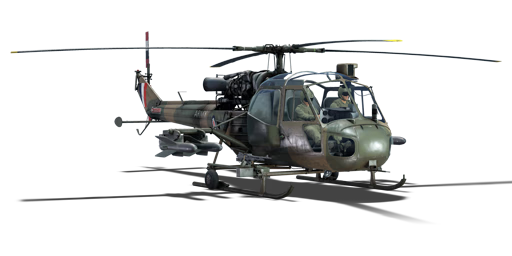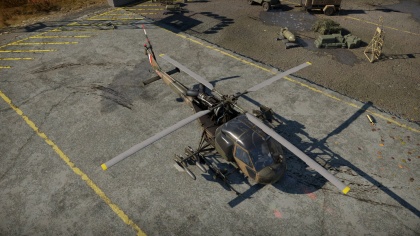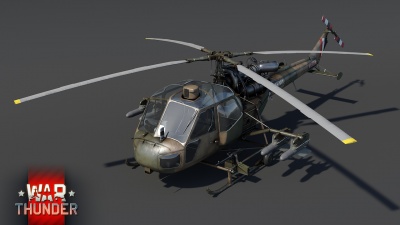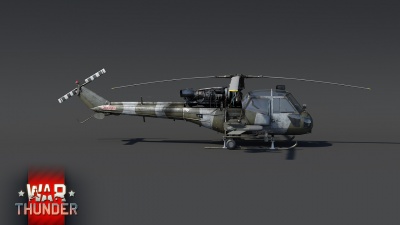Difference between revisions of "Scout AH.Mk.1"
m (added images and removed redundant info) (Tag: Visual edit) |
(Edits) |
||
| Line 9: | Line 9: | ||
== General info == | == General info == | ||
=== Flight performance === | === Flight performance === | ||
| + | ''Describe how the helicopter behaves in the air. Speed, manoeuvrability, acceleration and allowable loads - these are the most important characteristics of the vehicle.'' | ||
{| class="wikitable" style="text-align:center" | {| class="wikitable" style="text-align:center" | ||
| Line 21: | Line 22: | ||
! AB !! RB | ! AB !! RB | ||
|- | |- | ||
| − | | | + | | 196 || 186 || {{Specs|ceiling}} |
|- | |- | ||
! colspan="3" | ''Upgraded'' | ! colspan="3" | ''Upgraded'' | ||
| Line 35: | Line 36: | ||
=== Survivability and armour === | === Survivability and armour === | ||
| − | The Scout does not fly with any protective armour or bullet-proof glass, which if installed would decrease the Scout's ability to complete its mission. As such, the pilot must take this into account and fly the helicopter accordingly. Bull rushing right into the middle of a battlefield usually ends with disastrous results as | + | <!-- ''Examine the survivability of the helicopter. Note how vulnerable the structure is and how secure the pilot is, whether the fuel tanks are armoured, etc. Describe the armour, if there is any, and also mention the vulnerability of other critical systems.'' --> |
| + | The Scout does not fly with any protective armour or bullet-proof glass, which if installed would decrease the Scout's ability to complete its mission. As such, the pilot must take this into account and fly the helicopter accordingly. Bull rushing right into the middle of a battlefield usually ends with disastrous results as without armour, the Scout has nothing but thin metal fuselage coverings to protect the crew and vital equipment. The engine, transmission, main rotor and tail rotors are all exposed to fire from missiles, rockets, cannons and even small calibre machine guns. | ||
== Armaments == | == Armaments == | ||
=== Offensive armament === | === Offensive armament === | ||
| + | <!-- ''Describe the offensive armament of the aircraft, if any. Describe how effective the cannons and machine guns are in a battle, and also what belts or drums are better to use. If there is no offensive weaponry, delete this subsection.'' --> | ||
| + | {{main|L8A1 (7.62 mm)}} | ||
| − | + | The '''''{{PAGENAME}}''''' is armed with: | |
| + | * 2 x 7.62 mm L8A1 machine guns, skid-mounted (167 rpg = 501 total) | ||
=== Suspended armament === | === Suspended armament === | ||
| + | <!-- ''Describe the aircraft's suspended armament: additional cannons under the wings, bombs, rockets and torpedoes. This section is especially important for bombers and attackers. If there is no suspended weaponry remove this subsection.'' --> | ||
| + | {{main|AGM-22}} | ||
| − | + | The '''''{{PAGENAME}}''''' can be outfitted with the following ordnance: | |
| + | * 4 x AGM-22 missiles | ||
== Usage in battles == | == Usage in battles == | ||
| + | <!-- ''Describe the tactics of playing in a helicopter, the features of using helicopter in a team and advice on tactics. Refrain from creating a "guide" - do not impose a single point of view, but instead, give the reader food for thought. Examine the most dangerous enemies and give recommendations on fighting them. If necessary, note the specifics of the game in different modes (AB, RB, SB).'' --> | ||
As the engine, transmission, main rotor and tail rotors are all exposed to enemy, the pilot must be aware of their surrounds and work to fight from the enemy vehicles blind spots or weak sides, because a burning and crashed helicopter only pads the enemies' score-count. Pick and choose your battles to preserve the helicopter. | As the engine, transmission, main rotor and tail rotors are all exposed to enemy, the pilot must be aware of their surrounds and work to fight from the enemy vehicles blind spots or weak sides, because a burning and crashed helicopter only pads the enemies' score-count. Pick and choose your battles to preserve the helicopter. | ||
| + | |||
| + | === Modules === | ||
| + | {| class="wikitable" | ||
| + | ! Tier | ||
| + | ! colspan="2" | Flight performance | ||
| + | ! Survivability | ||
| + | ! Weaponry | ||
| + | |- | ||
| + | | I | ||
| + | | Compressor | ||
| + | | | ||
| + | | Flak jacket | ||
| + | | | ||
| + | |- | ||
| + | | II | ||
| + | | | ||
| + | | | ||
| + | | Helicopter frame | ||
| + | | New 7 mm MGs | ||
| + | |- | ||
| + | | III | ||
| + | | Engine | ||
| + | | Replacing helicopter blades | ||
| + | | NVD | ||
| + | | | ||
| + | |- | ||
| + | | IV | ||
| + | | | ||
| + | | | ||
| + | | Cover | ||
| + | | | ||
| + | |- | ||
| + | |} | ||
=== Pros and cons === | === Pros and cons === | ||
| − | '' | + | <!-- ''Summarise and briefly evaluate the vehicle in terms of its characteristics and combat effectiveness. Mark its pros and cons in the bulleted list. Try not to use more than 6 points for each of the characteristics. Avoid using categorical definitions such as "bad", "good" and the like - use substitutions with softer forms such as "inadequate" and "effective".'' --> |
| + | '''Pros:''' | ||
* Light and nimble | * Light and nimble | ||
* Small profile | * Small profile | ||
| − | '''Cons''' | + | '''Cons:''' |
| − | |||
* Limited weaponry | * Limited weaponry | ||
| − | |||
| − | |||
== History == | == History == | ||
| + | <!-- ''Describe the history of the creation and combat usage of the helicopter in more detail than in the introduction. If the historical reference turns out to be too long, take it to a separate article, taking a link to the article about the vehicle and adding a block "/History" (example: <nowiki>https://wiki.warthunder.com/(Vehicle-name)/History</nowiki>) and add a link to it here using the <code>main</code> template. Be sure to reference text and sources by using <code><nowiki><ref></ref></nowiki></code>, as well as adding them at the end of the article with <code><nowiki><references /></nowiki></code>. This section may also include the vehicle's dev blog entry (if applicable) and the in-game encyclopedia description (under <code><nowiki>=== In-game description ===</nowiki></code>, also if applicable).'' --> | ||
Development on the Westland Scout began in the late 1950s, however not at the Westland company, but at Saunders-Roe. Saunders-Roe developed their Saro P.531 light utility helicopter, which itself was based on the design of a previous piston-powered helicopter. The Saro P.531 already had several prototypes built and tested by the time the company was acquisitioned by Westland, who in turn, decided to continue development of the P.531. | Development on the Westland Scout began in the late 1950s, however not at the Westland company, but at Saunders-Roe. Saunders-Roe developed their Saro P.531 light utility helicopter, which itself was based on the design of a previous piston-powered helicopter. The Saro P.531 already had several prototypes built and tested by the time the company was acquisitioned by Westland, who in turn, decided to continue development of the P.531. | ||
As a result, in the early 1960s, the Westland Scout was created. The Scout conducted its maiden flight in August 1960 and was well-received with both the British Army and Royal Navy during testing. Following the favorable reception, the helicopter was subsequently ordered into production for the Army as the Scout AH Mk.1. | As a result, in the early 1960s, the Westland Scout was created. The Scout conducted its maiden flight in August 1960 and was well-received with both the British Army and Royal Navy during testing. Following the favorable reception, the helicopter was subsequently ordered into production for the Army as the Scout AH Mk.1. | ||
| − | As work on the Scout steadily progressed, Westland continued developing a | + | As work on the Scout steadily progressed, Westland continued developing a navalized version of the vehicle in parallel. The ‘Sea Scout’, as it was initially designated, only featured several minor design differences from the base model, such as a wheeled undercarriage and foldable blades and tail section, along with some other differences. After being reviewed by the Royal Navy, the ‘Wasp’ as it eventually became known, entered service with the Royal Navy in 1963, alongside the Army's Scout. |
Both versions of the helicopter took part in combat operations during their service, most notably in Borneo, the Falklands and Northern Ireland. In the end, around 280 machines of both types were built, including export models. | Both versions of the helicopter took part in combat operations during their service, most notably in Borneo, the Falklands and Northern Ireland. In the end, around 280 machines of both types were built, including export models. | ||
| + | |||
| + | ''- From [https://warthunder.com/en/news/6318-development-westland-scout-wasp-sting-like-a-bee-en Devblog]'' | ||
== Media == | == Media == | ||
| − | [[File:Scout | + | <!-- ''Excellent additions to the article would be video guides, screenshots from the game, and photos.'' --> |
| − | [[File:Scout | + | ;Images |
| + | <div><ul> | ||
| + | <li style="display: inline-block;"> [[File:Scout ah.mk.1 wtwallpaper 001.jpg|none|thumb|400px|]] </li> | ||
| + | <li style="display: inline-block;"> [[File:Scout ah.mk.1 wtwallpaper 002.jpg|none|thumb|400px|]] </li> | ||
| + | </ul></div> | ||
== See also == | == See also == | ||
| − | ''Links to the articles on the War Thunder Wiki that you think will be useful for the reader, for example:'' | + | <!-- ''Links to the articles on the War Thunder Wiki that you think will be useful for the reader, for example:'' |
| − | + | * ''reference to the series of the helicopter;'' | |
| + | * ''links to approximate analogues of other nations and research trees.'' --> | ||
* [[Lynx AH.Mk.1]] | * [[Lynx AH.Mk.1]] | ||
* [[Wasp HAS.Mk.1]] | * [[Wasp HAS.Mk.1]] | ||
| Line 82: | Line 130: | ||
== External links == | == External links == | ||
''Paste links to sources and external resources, such as:'' | ''Paste links to sources and external resources, such as:'' | ||
| − | |||
* ''topic on the official game forum;'' | * ''topic on the official game forum;'' | ||
* ''encyclopedia page on the helicopter;'' | * ''encyclopedia page on the helicopter;'' | ||
Revision as of 14:06, 23 October 2019
Contents
Description
The Scout AH.Mk.1 is a rank British helicopter
with a battle rating of (AB), (RB), and (SB). It was introduced in Update 1.91 "Night Vision".
General info
Flight performance
Describe how the helicopter behaves in the air. Speed, manoeuvrability, acceleration and allowable loads - these are the most important characteristics of the vehicle.
| Characteristics | ||
|---|---|---|
| Stock | ||
| Max Speed (km/h at 1,000 m) |
Max altitude (meters) | |
| AB | RB | |
| 196 | 186 | |
| Upgraded | ||
| Max Speed (km/h at 1,000 m) |
Max altitude (meters) | |
| AB | RB | |
| ??? | ??? | |
Survivability and armour
The Scout does not fly with any protective armour or bullet-proof glass, which if installed would decrease the Scout's ability to complete its mission. As such, the pilot must take this into account and fly the helicopter accordingly. Bull rushing right into the middle of a battlefield usually ends with disastrous results as without armour, the Scout has nothing but thin metal fuselage coverings to protect the crew and vital equipment. The engine, transmission, main rotor and tail rotors are all exposed to fire from missiles, rockets, cannons and even small calibre machine guns.
Armaments
Offensive armament
The Scout AH.Mk.1 is armed with:
- 2 x 7.62 mm L8A1 machine guns, skid-mounted (167 rpg = 501 total)
Suspended armament
The Scout AH.Mk.1 can be outfitted with the following ordnance:
- 4 x AGM-22 missiles
Usage in battles
As the engine, transmission, main rotor and tail rotors are all exposed to enemy, the pilot must be aware of their surrounds and work to fight from the enemy vehicles blind spots or weak sides, because a burning and crashed helicopter only pads the enemies' score-count. Pick and choose your battles to preserve the helicopter.
Modules
| Tier | Flight performance | Survivability | Weaponry | |
|---|---|---|---|---|
| I | Compressor | Flak jacket | ||
| II | Helicopter frame | New 7 mm MGs | ||
| III | Engine | Replacing helicopter blades | NVD | |
| IV | Cover | |||
Pros and cons
Pros:
- Light and nimble
- Small profile
Cons:
- Limited weaponry
History
Development on the Westland Scout began in the late 1950s, however not at the Westland company, but at Saunders-Roe. Saunders-Roe developed their Saro P.531 light utility helicopter, which itself was based on the design of a previous piston-powered helicopter. The Saro P.531 already had several prototypes built and tested by the time the company was acquisitioned by Westland, who in turn, decided to continue development of the P.531.
As a result, in the early 1960s, the Westland Scout was created. The Scout conducted its maiden flight in August 1960 and was well-received with both the British Army and Royal Navy during testing. Following the favorable reception, the helicopter was subsequently ordered into production for the Army as the Scout AH Mk.1.
As work on the Scout steadily progressed, Westland continued developing a navalized version of the vehicle in parallel. The ‘Sea Scout’, as it was initially designated, only featured several minor design differences from the base model, such as a wheeled undercarriage and foldable blades and tail section, along with some other differences. After being reviewed by the Royal Navy, the ‘Wasp’ as it eventually became known, entered service with the Royal Navy in 1963, alongside the Army's Scout.
Both versions of the helicopter took part in combat operations during their service, most notably in Borneo, the Falklands and Northern Ireland. In the end, around 280 machines of both types were built, including export models.
- From Devblog
Media
- Images
See also
External links
Paste links to sources and external resources, such as:
- topic on the official game forum;
- encyclopedia page on the helicopter;
- other literature.
| Britain helicopters | |
|---|---|
| Attack | AH Mk.1 Apache · Rooivalk Mk1F CSH · Superhind |
| Utility | Wessex HU Mk.5 · Scout AH.Mk.1 · Wasp HAS.Mk.1 · Lynx AH.Mk.1 · G-LYNX |







